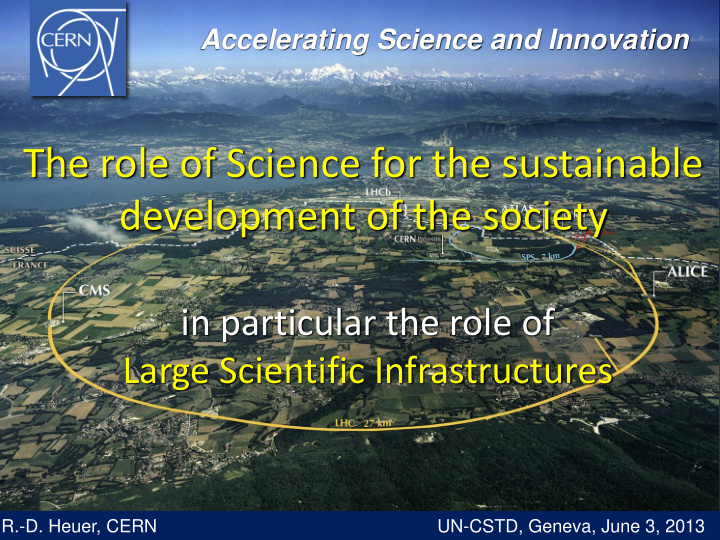



Accelerating Science and Innovation The role of Science for the sustainable development of the society in particular the role of Large Scientific Infrastructures R.-D. Heuer, CERN UN-CSTD, Geneva, June 3, 2013
Key Message In today’s challenging period, all regions need to step up support for research and innovation in order to ensure, in a global competitive environment, the sustainable development of science and technology necessary for the upturn and growth of everybody’s economy. Research Infrastructures (RIs) are important ‘tools’ for this are vital for large scale projects
Mission of Research Infrastructures Research Push forward the frontiers of knowledge Innovation Develop new, cutting-edge technologies Education Train scientists and engineers of tomorrow Outreach Promote Science in Society
Research generates Knowledge generates Innovation can generate Disruptive Innovation thereby changing society Example from CERN: World Wide Web
The Virtuous Circle basic research ↔ innovation ↔ applied research • Synergy between research and innovation results not only in societal and economic impact but also, and very importantly, in the creation of enhanced opportunities for further developments. • This circle needs to remain strong, to be unbroken and to be supported over long term.
Excellence • Objective - strive for excellence – Aspects of excellence • In individuals, co-operation, infrastructure (including intellectual challenges); • National - Regional - International. – Excellence is not (necessarily) ‘being unique’; Competition promotes excellence. – Excellence will be attractive and inspiring to all region’s research and innovation communities and to society at large .
Cooperation - International scientific cooperation is vital CERN: European Infrastructure, globally used - International scientific cooperation is vital for all countries: developed, emerging, developing scientific research needs to benefit everybody - International scientific cooperation provides successful models for peaceful cooperation
Large-scale Science Projects Address - fundamental science questions at the forefront of research and technology Need - large and sustained infrastructures - global collaboration on long time scales Provide - unique equipment - challenging requests for high technology and innovation - stimulating ideas which in turn attract good people - occasion to bring people together
Sociology Large International Collaborations – a place where people learn to work together – collaboration and competition – diversity: good opportunity to recognize differences, accept them and learn to use them – influence the way of thinking, planning at general level – information sharing: role of computing in internationalization and communication – experience can be used by individuals and in other fields management through ‘common goals’ management by ‘convincing partners’
Key Issue: Outreach - All countries need more scientists, engineers, staff, . . . - targeted outreach activities - encourage interest in careers in science - Society needs to realize and appreciate science - bring innovative science and exciting results (achieved at RIs), and their application to societal challenges, to the notice of society - need more imaginative and ambitious outreach activities
Key Issue: Access to Results - circulation of scientific knowledge needs to be improved - huge, strongly increasing amount of data and information - data preservation - open access to scientific publications - open access to data Everybody, independent of region, country, culture has to be able to access scientific results but also to make his/her available to everybody else
Key Message Governments and decision-makers should not cut on scientific research, as this would reduce the perspectives of growth for the society, and for the welfare of its citizens.
The role of Large Scientific Infrastructures: – innovate, discover, publish, share … and bring the world together
Recommend
More recommend